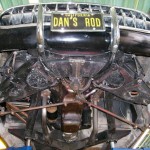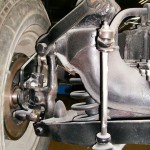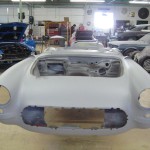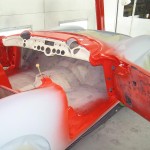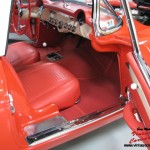1957 Chevrolet Corvette
This 1957 Chevrolet Corvette was a labor of love for Dan’s wife Melissa. It is a true numbers matching vehicle, because Dan wanted it to be perfect, just like Melissa.
Explore the Project Galleries
Arrival
Disassembly
Mechanical
Body & Paint
Finish
Motor Trend tested one of the first Chevrolet Corvettes and found it traipsing from zero to 60 mph in a lackadaisical 11.5 seconds. But the publication was not completely unimpressed with the car. “Probably one of the biggest surprises I got with the car was when I took it through some sharp corners at fairly good speeds,” its writer reported. “I’d heard that Chevrolet had designed the suspension so that it would stay flat and stick in corners, but I took it with several grains of salt. It sticks better than some foreign sports cars I’ve driven.”
The year 1955 brought the single most important development in the history of the Corvette: Chevrolet’s brilliant small-block V8. Originally displacing 265 cubic inches, the first small-block was rated at 195 hp in the otherwise almost unchanged ’55 Corvette (the most notable tweak was the oversize “V” in the lettering along the front fenders). Still saddled with the Powerglide transmission, performance was still less than scintillating (Road & Track had a ’55 getting to 60 mph in 8.5 seconds), but the potential was obvious. With many ’54 Corvettes still clogging dealer lots, GM restricted production of the ’55 model to just 700 cars, with all but maybe a half dozen of them being powered by the new V8.
Visually, the 1957 edition was virtually identical to the ’56, but inside, a four-speed manual transmission (the great T-10) was available for the first time. The standard Corvette engine grew to 283 cubic inches and 220 hp, breathing through a single four-barrel carburetor. Best of all, for the first time, Chevrolet offered performance-upgraded engines as options. In addition to the base configuration, the 283 could be had with dual-quad carbs rated at either 245 or 270 hp or, best of all, with Rochester mechanical fuel injection.
Fuel injection on top of the 283 increased its output to either 250 or 283 hp: 1 hp per cubic inch. The top engine probably made more than that, but the ad agency loved that one-cube/one-pony hook. Suddenly, the Corvette was one of the world’s truly quick cars and it drove beautifully. “The function of the fuel injection system was notable,” wrote Motor Trend‘s Walt Woron at the time. “Starts were quick. Pumping the throttle didn’t pump raw gas to the cylinders, so you can’t flood it. Throttle response is instantaneous. No maneuver could flood or starve the engine (and I tried with violent cornering and hard braking).” Road & Track had one ’57 “Fuelie” catapulting to 60 mph in just 5.7 seconds. Still, though Chevy built 6,339 Corvettes during the ’57 model year, only 1,040 of them had the fuel-injected engine.
Read more about Corvettes at: http://www.edmunds.com/chevrolet/corvette/history.html









